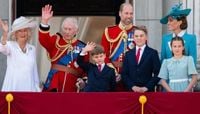In the heart of London, a quiet but dramatic shift in property ownership has unfolded over the past decade, transforming the city’s skyline and its luxury property market. While many still associate the British royal family with London’s grandest estates, official palaces, and storied landmarks, new data reveal that it is actually a foreign royal house—the House of Al-Thani from Qatar—that now holds the city’s largest private real estate empire. The scale and scope of this ownership have left many Londoners, and even seasoned real estate watchers, astonished.
According to reporting from GB News and corroborated by News18, the Al Thani royal family of Qatar owns an extraordinary 1.8 million square feet of prime London property. That’s not just a few townhouses or a handful of luxury apartments—this is a sprawling portfolio valued at approximately £2.4 billion. For comparison, King Charles III and the British royal family, though synonymous with Buckingham Palace and other iconic sites, simply do not hold as much private property in the capital as their Qatari counterparts.
How did this come to be? The answer lies in a combination of strategic investments, high-profile acquisitions, and a vision that stretches far beyond the borders of Qatar. The patriarch of the family, Sheikh Tamim bin Hamad Al Thani—the Emir of Qatar—alone is reported to own around £1.6 billion worth of London real estate. The family’s holdings are so extensive in certain neighborhoods that northwestern Mayfair has earned the nickname "Little Doha," a nod to the Qatari capital. In fact, about a quarter of Mayfair’s real estate is now under the Al Thani family’s control, including some of Britain’s most valuable private homes.
But it’s not just residential properties that have drawn the Qatari royals’ attention. Their investments have reshaped the commercial and cultural landscape of London as well. In 2010, the Qatar Investment Authority—Qatar’s sovereign wealth fund, established by the state—made headlines when it purchased Harrods, the world-famous department store, for a reported £1.5 billion. This acquisition was more than a trophy buy; it signaled Qatar’s intent to become a major player in London’s economy and social scene.
The family’s reach extends into hospitality, too. Mohammed Bin Hamad Bin Jassim Bin Jaber Al-Thani, a Qatari politician and royal family member, serves as a director of Maybourne Hotels. This group operates some of London’s most exclusive and storied hotels: The Berkeley, The Connaught, Claridge’s, and The Emory. These establishments are not just places to stay—they are institutions in their own right, frequented by celebrities, dignitaries, and the global elite.
Qatar’s investments in London go even higher—literally. The state owns a staggering 95% of The Shard, the tallest building in Western Europe. Standing at 310 meters, The Shard has become a defining feature of the London skyline, visible for miles around. But the Qatari footprint doesn’t stop there. The Qatar Investment Authority also co-owns Canary Wharf, the privately owned financial district that rivals the City of London as the capital’s business heart. This means that, in addition to luxury homes and hotels, the Qataris have a controlling interest in some of London’s most important commercial real estate.
Transport and retail have not been overlooked, either. The Qatar Investment Authority holds a 20% stake in Heathrow Airport, one of the world’s busiest international travel hubs. Meanwhile, the family owns a 14.3% stake in Sainsbury’s, one of Britain’s largest supermarket chains. These investments underscore a strategy that is as much about influence and integration into British life as it is about financial return.
Contrast this with the holdings of the British royal family, whose most famous properties—Buckingham Palace, St James’s Palace, Kensington Palace, and Clarence House—are not actually private assets. Instead, these palaces are owned by the sovereign on behalf of the nation as part of the Crown Estate, a centuries-old arrangement that ensures these landmarks remain public institutions. The Tower of London and Hampton Court Palace, similarly, are held by the Crown Estate and are not considered personal property of the monarch.
This distinction is crucial. While the British royal family undoubtedly enjoys the use of some of the world’s most iconic residences, their personal real estate portfolio is dwarfed by the private holdings of the Al Thani family. As GB News put it, "The British royal family's personal foothold in the capital is dwarfed by another royal house."
The Al Thani family’s rise as London’s preeminent private landowners is not without its implications. For one, it highlights the increasingly global nature of the city’s real estate market. London has long been a magnet for international capital, but the scale of Qatar’s investments—spanning homes, hotels, landmarks, and infrastructure—marks a new chapter in the city’s evolution. It also raises questions about the visibility and influence of foreign wealth in Britain’s capital, a topic that has sparked debate in Parliament and among the public.
Yet, for all the commentary, the facts are plain: the House of Al-Thani has built an empire in London that surpasses even the city’s own royal family. As News18 reported, "The Al Thani royal family of Qatar has surpassed King Charles as the largest landowner in London." Their holdings are not only vast but strategically chosen, encompassing both the city’s heritage and its future.
It’s a remarkable story of ambition, investment, and transformation—one that continues to unfold as the Qatari royals deepen their ties to London. Whether this trend will continue or spark a new wave of domestic investment remains to be seen. For now, though, the answer to the question "Who owns more of London than King Charles?" is clear—and it’s not anyone from the House of Windsor.

